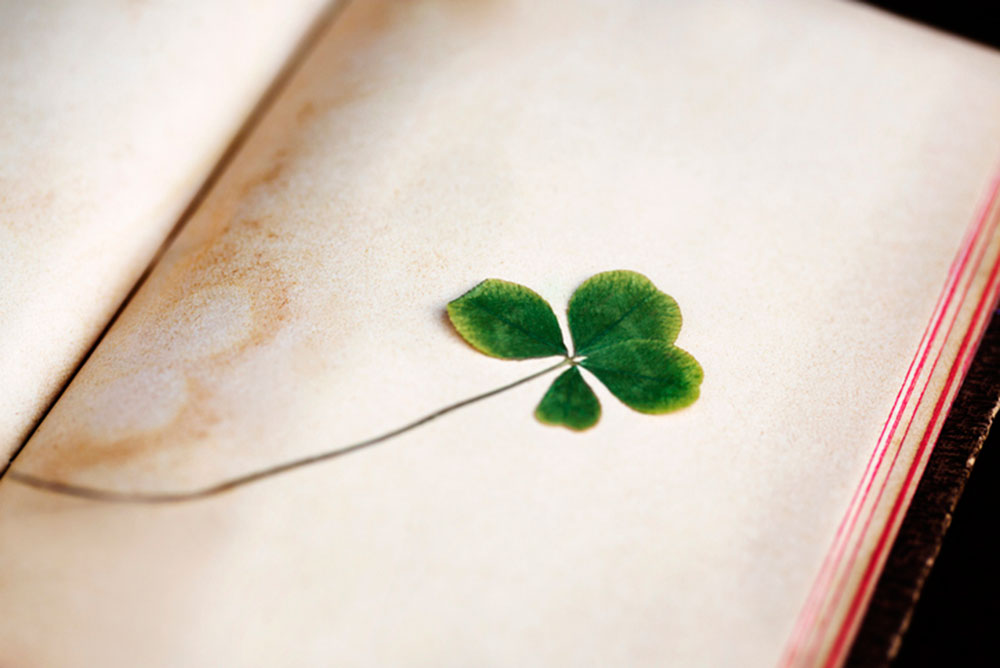
iStock photo.
IN THE New York Times Magazine this past Sunday (page 19, if you’re interested) is a crib sheet on finding four-leaf clovers. Over the course of her lifetime, an unspecified period, Leslie Hirst has found tens of thousands of them; they’ve all been pressed and properly stored.
—-
An artist and professor at the Rhode Island School of Design, Hirst once found 333 in a single day. Science, they tell us, explains that only one in 10,000 plants sports four leaflets, so this is quite an achievement.
—-
In my lifetime I have found two, and one of those was pressed into the pages of an unabridged dictionary I picked up at a yard sale. Printed in 1938, it includes color plates of maps of long-gone places such as Siam. This is neither here nor there but interesting.
—-
Baby says her friend Julia finds them all the time, “a completely useless but delightful talent.” Like Hirst, Julia is an artist: Is this an artistic trait?
—-
On Baby’s wedding day Julia said, “Would you like me to find you one?” She glanced down at the patch of grass they were standing in, plucked one up and held it out. “Here.” Easy as that.
—-
Tip No. 1: Look out for interruptions in the clover pattern. Hirst claims she can spy them at a full run. Runners, they say, get into this perfect zen-like state, zoned out and unfocused. If you just eyeball a clover patch as you breeze by they’ll pop right out at you, or words to that effect.
—-
Tip No. 2: If you don’t see any right away, move on. Not every patch of clover includes a four-leafer or 300.
—-
Tip No. 3: Do not let the clover know you’re serious about finding them. Let your eyeballs glide across the surface, and repeat, “I do not care if there’s a four-leaf clover there.” I made all of that up, but I think it’s good.
—-
Tip No. 4: They’re easiest to see in the shade, but do not look for them in the dark. They’re nyctinastic, which is a really useful word I just learned, meaning they fold inward at night. For extra credit, please write 10 sentences that include the word.
—-
There are several explanations for why four-leaf clovers are considered particularly lucky. I like the one that says they can assist in seeing fairies. Four-leafed or not, clover is considered a lucky plant. If you’re “living in clover” you’re in the lap of luxury, having a lucky life. Meanwhile fusspots attempt to eradicate it from their Kentucky Blue Grass and Fussy Fescue.
—-
Time was, most lawns had patches of the stuff, and at the Old Farmer’s Almanac, they think it’s high time for a return to such mixed lawns, lucky or not.
—-
There are 300 clover species (genus trifolium). A member of the pea family, they come in shades of crimson and white. Being a legume, they convert nitrogen to fertilizer, practically eliminating the need for additional fertilization. They’re also drought- resistant, stay green in the heat and attract butterflies and bees and other good bugs that fight bad bugs.
—-
This is an admirable collection of characteristics. Combined with grass, clover also makes a pretty ground cover. “Mix 5 to 10 percent clover seed with grass seed to create a thick stand,” the old farmers say.
—-
Tip No. 5: They’re easiest to find in the spring, “before the first mowing.” Unfortunately, for me at least, I have enough trouble remembering what I just walked into the kitchen for, never mind remembering to look for four-leaf clover in six months.
—-
Tip No. 6: Do not try hunting for four-leaf clovers while walking your 65-pound grand-dog, who is probably hunting for cats.
—-
You are probably not in a zen-like state.
—Stephanie Cavanaugh
LittleBird “Stephanie Gardens” doesn’t have a clover field in her urban backyard, but she can dream.

What a lot of research – but well worth it. Will never see (now, that would be lucky day) or hear about a four-leaf clover again without recalling some of the knowledge gleaned from this piece – which to me has the makings of a book.